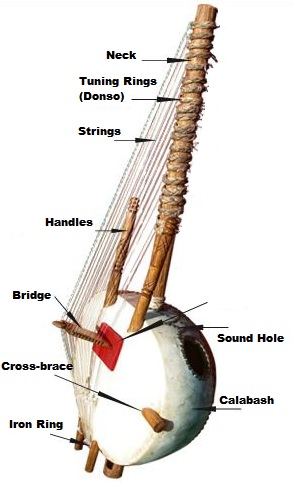How a kora is made
Kora Construction
The kora’s body is constructed from a large calabash gourd, cut in half and then covered in animal skin (usually cow skin). This acts as a resonator, to amplify the sound from the strings. Two handles run under the skin, these are usually made from the same hardwood as the kora’s neck. A notched, double free-standing bridge sits on the surface of the body.
Strings are arranged in two ranks and are held in notches on the bridge. Traditionally, these would have been made from thin strips of animal hide. African players today usually use nylon fishing line for strings which is easily and cheaply obtained, but western players often use harp strings instead. For the bass strings, it may be necessary to plait together several lengths of fishing line, to produce the necessary thickness. Below the bridge, the strings are knotted to anchor strings. The anchor strings are looped around an iron ring bored through the base of the kora’s neck.
The number (and arrangement) of strings is not identical in all instruments, but most koras have twenty one, the traditional number, with eleven strings played by the left hand with ten strings on the right. Today, some instruments have additional bass strings (sometimes up to 4), particularly those from the Casamance region in Senegal. These extra strings usually run over the end of the bridge, rather than being inserted into notches in the bridge like the other strings.
The neck is a rounded piece of wood (traditionally kéno, rosewood) which must be uniform, straight, free of knots, and usually has a diameter of around 3-4 cm. The neck is typically from 110-135 cm long.
A piece of iron at the end of the neck holds it in place – this will be used later to attach strings. It is made by a blacksmith specifically for use in kora building. It is around a centimetre thick and has a ring at one end to hold the anchor strings. The other end is drilled through the bottom on the neck and tied to it.
The placement of the handles is important as they will later support the bridge. They pass through the skin, but not the gourd itself. There is also a horizontally inserted strengthening crossbar piece. The handles and this transverse crossbar are also made from a smooth rod of kéno wood, typically 2-3 cm in diameter. The crossbar needs to be a little longer than the width of the gourd. The length of the handles is a matter of individual preference but will usually be around 60-80cm.
A traditional instrument has tuning rings (konso) made from plaited leather which must be on the neck before it is inserted. Traditionally, tuning the instrument was a time-consuming and difficult process. By raising or lowering the tuning rings on the neck, each string could be tuned to the correct pitch. However, it was often necessary to adjust the length of the string itself in order to reach the correct tuning, which required pulling the string through the tuning ring, with a needle. For this reason, those learning to play would typically not be allowed to tune their own instruments.
However, it is now common for tuning pegs to be used in place of the traditional leather rings.
A detachable wooden bridge, in which one notch for each string has been cut, is used. The slots for the strings are around 10mm deep and are sanded to avoid damage to strings.A rectangle shaped pad is placed on the instrument and the bridge sits on top of this. Traditionally, it is covered in a red cloth.
The strings are slotted through notches and tied to anchor strings at the bottom.
The bridge lifts the strings so that they are at right angles to the sound table, in two rows, eleven strings on the left and ten on the right. These two rows get closer together as they get closer to the body of the instrument.
A hole is cut into the gourd, similar to the sound hole of a guitar or violin. In addition to allowing the sound of the strings to be amplified, it may also used to store spare strings, and as a place for listeners to slip bank notes as a reward to the musician.

Different parts of the kora
